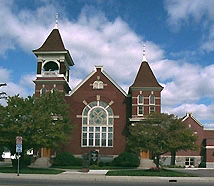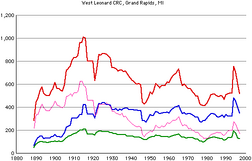
West Leonard CRC, Grand Rapids, MI
History
West Leonard CRC was organized in 1889 by members of Alpine Ave. CRC. West Leonard (then Crosby Street) was the seventh Christian Reformed congregation in Grand Rapids.
West Leonard cosponsored Twelfth Street CRC in 1917, and that congregation merged with West Leonard in 1994.
Historical Details
Names
- Crosby Street
- West Leonard
Locations
- north side of Crosby Street near Garfield Ave. NW, 1889-1908
- 1053 Leonard NW, Grand Rapids, MI 49504 (built 1912, addition 19__)
Pastors
- Geert Broene, 1889-1904
- Frank Doezema, 1905-14
- R. B. Kuiper, 1914-17
- S. P. Eldersveld, 1918-20
- J. P. De Vries, 1921-26
- Richard Veldman, 1927-48
- C. Vanden Heuvel, 1949-58
- R. Leetsma, 1958-64
- A. A. Mulder, 1965-70
- E. J. Knott, 1971-78
- D. J. Deters, 1979-84
- H. J. Weidenaar, 1984-88
- Arlan W. Koppendrayer, 1989-93
- John L. Hoekwater, 1994-
- Neil Jasperse
Daughter Churches
- Twelfth Street, 1917-1995, cosponsored with Alpine Ave.
- Bristolwood, 1961-66
Merger
- Twelfth Street, 1994
Membership Overview
Looking at membership data, it is disappointing to see that West Leonard has less families, less total members, and a significantly lower youth ratio than it did before the merger in 1994.

Membership data, West Leonard CRC, Grand Rapids, MI
Membership Data
Green (lower) line shows membership in families; blue (middle), professing members; red (top), total members; and magenta (thin), non-professing members. Note effect of merger with Twelfth Street CRC in 1994.

Youth ratio, West Leonard CRC, Grand Rapids, MI
Youth Ratio
Red line shows nonprofessing members as a percentage of total membership.

Five year growth rate, West Leonard CRC, Grand Rapids, MI
Five Year Growth Rate
Red line shows five year growth rate. A five year growth rate between 10% and -10% is considered stable; greater than 10% indicates a growing congregation; one below -10% indicates a church in decline. This makes no allowance for daughter churches.
Data source: Yearbooks of the Christian Reformed Church. Dates are year prior to publication date since data is gathered at the end of one year and published in the next.